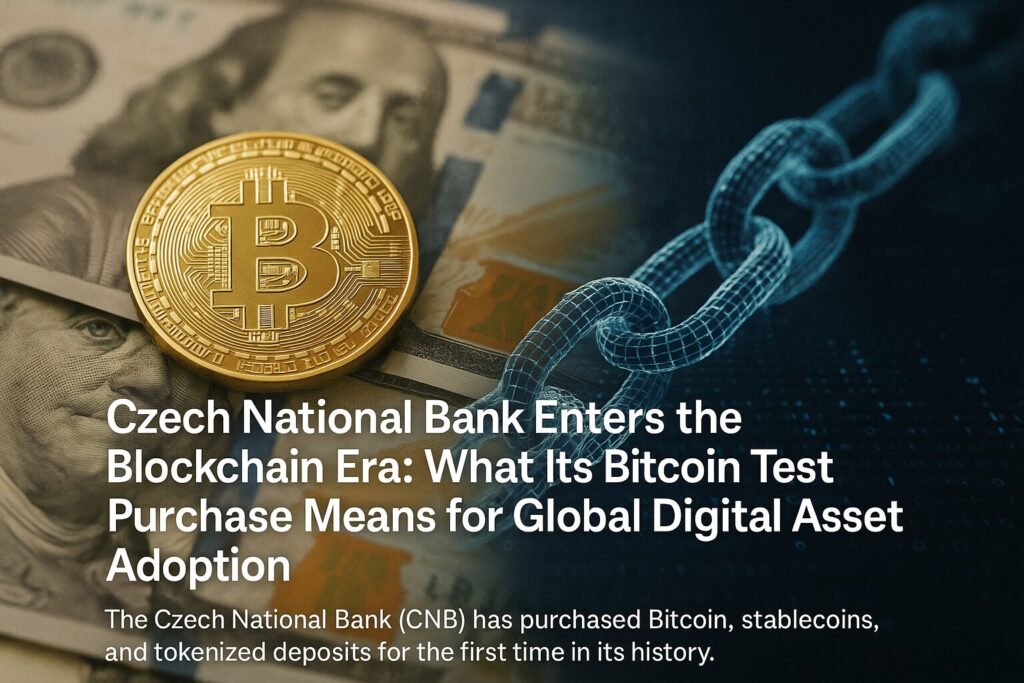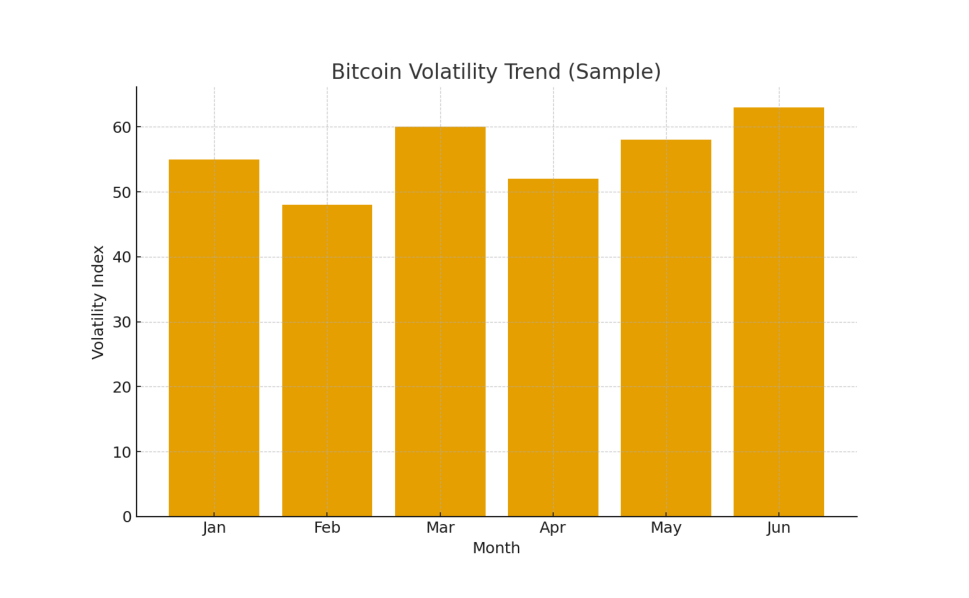
Main Points :
- The Czech National Bank (CNB) has purchased Bitcoin, stablecoins, and tokenized deposits for the first time in its history.
- The $1 million experimental digital asset portfolio aims to test real-world ownership, custody processes, and blockchain-based finance.
- This move aligns with a growing global trend of central banks exploring tokenized assets, settlement solutions, and digital currencies.
- CNB simultaneously launched a new innovation unit, CNB Lab, to test blockchain, AI tools, and payments innovation.
- While CNB warns of Bitcoin’s volatility risks, the pilot signals growing institutional acceptance and future possibilities for tokenized finance.
- This development presents new opportunities for Web3 builders, investors searching for new crypto assets, and entrepreneurs focused on practical blockchain use cases.
1. Introduction – A Historic First for the Czech National Bank
The Czech National Bank (CNB) announced on November 13 that it had purchased Bitcoin (BTC) for the first time in its history. Alongside Bitcoin, the bank also acquired U.S. dollar stablecoins and tokenized deposits, forming a $1 million experimental digital asset portfolio separate from its traditional foreign reserves.
This groundbreaking decision marks a significant shift in the way central banks interact with blockchain-based assets. For a long time, digital assets were viewed as either too volatile or too immature for central bank experimentation. However, this pilot program demonstrates how rapidly perceptions are changing as tokenization, stablecoins, and decentralized settlement architecture evolve.

2. Why the Czech National Bank is Testing Bitcoin and Tokenized Deposits
2.1. Strategic Purpose
According to Governor Aleš Michl, the primary goal is to gain hands-on operational experience with blockchain systems. The CNB emphasized that the purchase is not an investment strategy nor a step toward adding Bitcoin to official reserves.
Instead, the goal is to:
- Experience real-world digital asset custody
- Test reconciliation, settlement, and reporting of tokenized assets
- Understand operational and regulatory challenges
- Evaluate how digital assets interact with future payment systems
2.2. Seeded by Institutional Trends
The decision was influenced by the rapid institutionalization of digital assets globally:
- U.S. spot Bitcoin ETFs accumulated millions of BTC within months of approval
- Major banks like JPMorgan and HSBC now use tokenized deposits and blockchain settlement tools
- More than 100 countries are testing or researching CBDCs and tokenization pilots
Given these developments, CNB concluded that not testing blockchain-based finance poses more risk than testing it.
3. Bitcoin’s Role in the Portfolio
The inclusion of Bitcoin is particularly symbolic. Many central banks have been hesitant to engage with BTC directly due to:
- Price volatility
- Regulatory uncertainty
- Lack of traditional financial classification
Still, Bitcoin remains the largest and most liquid digital asset, making it an ideal instrument for testing blockchain operations such as:
- Wallet transactions
- Public chain monitoring
- Secure storage
- Auditable on-chain records
However, the CNB stressed that Bitcoin will not be added to official foreign reserves in the near term, and it warned investors about the potential for large price swings.
4. Stablecoins and Tokenized Deposits: The Practical Layer
While Bitcoin is useful for infrastructure testing, stablecoins and tokenized deposits offer direct implications for the future of payments.
4.1. Stablecoins
The bank purchased USD stablecoins to test:
- Blockchain-based settlement
- Liquidity flows
- Counterparty risk
- Off-chain redemption mechanics
Stablecoins continue to grow rapidly as payment instruments. Several major financial institutions are already using them for cross-border settlement.
4.2. Tokenized Deposits
Tokenized deposits represent the next evolution of bank accounts—deposits recorded on blockchain rather than in traditional ledgers.
These offer:
- Instant settlement
- Lower operational friction
- Automated compliance
- On-chain auditability
For central banks, learning how commercial banks tokenize deposits is essential for supervising future digital financial markets.
5. Timeline and Scope of the Pilot Program
The test will run for 2–3 years, according to Governor Michl. During this period, CNB will:
- Share insights publicly
- Monitor risk behaviors
- Evaluate technology providers
- Test operational compatibility
- Study implications for monetary policy and banking stability
The pilot remains limited in financial size, as the CNB has no intention of scaling the investment amount aggressively.
6. CNB Lab – The New Innovation Arm
Alongside the portfolio announcement, the Czech National Bank revealed a bold new initiative: CNB Lab.
This unit will:
- Oversee testing of digital assets and tokenized financial instruments
- Explore AI tools for financial sector analytics
- Study innovation in the payments sector
- Lead digital transformation projects within financial supervision
The CNB Lab mirrors efforts by other major regulators:
- The U.S. Federal Reserve’s “Innovation Office Hours”
- The UK’s Bank of England’s digital financial initiatives
- The Monetary Authority of Singapore (MAS) Project Guardian
This signals that the Czech Republic intends to play a role in shaping global financial innovation.

7. How This Affects Investors and Builders Seeking New Crypto Opportunities
This event is highly relevant for the user base described—those seeking new income sources, new crypto assets, and practical blockchain adoption.
7.1. Increased Legitimacy for Tokenized Finance
When a central bank begins testing tokenized deposits and stablecoins, it:
- Adds credibility to the sector
- Encourages banks and fintechs to begin proofs-of-concept
- Expands institutional demand for tokenized assets
7.2. Bitcoin’s Role as a Test Instrument Strengthens Its Institutional Case
Even though CNB emphasizes risks, the simple fact that it included BTC signals:
- Recognition of Bitcoin as a mature financial instrument
- Growing comfort in handling it operationally
- Its use as a standardized digital asset for testing
7.3. Practical Blockchain Use-Cases Gain Momentum
The CNB Lab’s involvement in:
- Payments innovation
- Digital asset testing
- AI x finance
creates many opportunities for entrepreneurs building: - Non-custodial wallets
- Tokenization solutions
- Cross-border settlement rails
- Regtech and KYT systems
7.4. Regional and Global Domino Effect
Central banks often follow peer institutions.
After this pilot:
- Neighboring EU central banks may start similar tests
- Emerging economies may use tokenization pilots to modernize payment rails
- Commercial banks may accelerate their own experiments
For investors, this suggests:
- Increasing demand for infrastructure tokens
- Growth of enterprise blockchain tools
- A long-term direction toward hybrid finance (“TradFi + DeFi blending”)
8. Current Global Trends Supporting CNB’s Decision
To make the article more comprehensive, here are notable global developments as of late 2025:
- Tokenized treasury markets exceeded $2B in assets
- Singapore’s MAS Project Guardian expanded to include global banks
- Circle’s USDC became integrated into major payments platforms
- JPMorgan’s JPM Coin surpassed $1 trillion in settlement volume
- Bitcoin ETFs continued to attract large institutional inflows
- Solana-based tokenization pilots improved settlement speeds
- EU MiCA regulations created more clarity for stablecoins
All of these reinforce why a central bank wants to understand digital assets operationally.
9. Conclusion – A Signal of the Next Financial Era
The Czech National Bank’s decision is not merely an experiment—it is a signal.
A signal that the world’s financial architecture is moving toward a future where:
- Tokenized deposits coexist with traditional banking
- Stablecoins integrate with global settlement flows
- AI tools redefine financial supervision
- And Bitcoin transitions from a speculative asset to a standardized digital infrastructure instrument
For builders, investors, and innovators, this moment represents expanding opportunity. Digital assets are no longer purely speculative—they are becoming part of the institutional toolkit that will shape global finance for the next decade.

